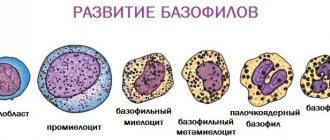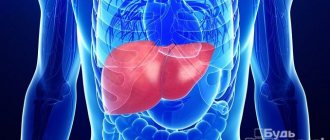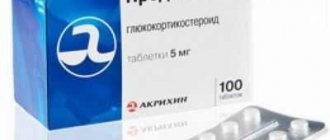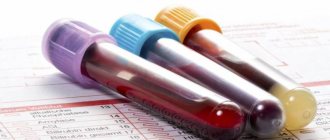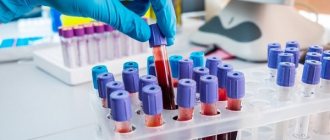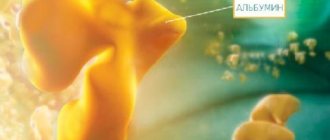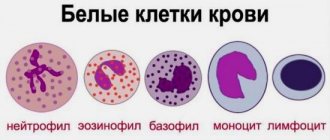Determination of chlorine concentration by mercurimetric method
Principle
Serum, urine and cerebrospinal fluid chlorides are titrated with mercuric nitrate using diphenylcarbazone as an indicator. At the equivalent point, an excess of mercury ions forms a complex with the indicator, colored blue-purple.
Normal values
| Whole blood (coulometry) | 77‑87 mmol/l |
| Serum (unified) | |
| children under 1 year | 80‑140 mmol/l |
| adults | 95‑110 mmol/l |
| Urine (same) | |
| children under 1 year | 2‑30 mmol/day |
| children 1-2 years old | 14‑40 mmol/day |
| adults | 170‑210 mmol/day |
| Cerebrospinal fluid (same) | |
| children | 111‑130 mmol/l |
| adults | 120‑130 mmol/l |
| Daily feces (coulometry) | 2 mmol/day |
| Red blood cells (same) | 54‑95 mmol/l |
| Sweat (using an ion selective electrode) | 0‑35 mmol/l |
| Saliva (same) | 5‑20 mmol/l |
| Gastric juice | on average 155.1 mmol/l |
Influencing factors
An increase in the concentration of chlorides in the blood is caused by androgens, corticosteroids, thiazide diuretics, and acetazolamide. Reduction - bicarbonates, ACTH, corticosteroids, diuretics, laxatives.
Serum
An increase in the concentration of chloride ions is observed with dehydration caused by insufficient fluid intake, with nephritis, nephrosis, nephrosclerosis, with a large intake of chlorides, cardiac decompensation, hyperventilation (respiratory alkalosis), stimulation or damage to the hypothalamus, hypofunction of the adrenal cortex.
A decrease is detected with dehydration caused by vomiting, diarrhea, prolonged sweating, pyloric stenosis, renal diabetes, gastric hypersecretion, adrenal insufficiency, an increase in the volume of extracellular fluid, infectious diseases and other pathological conditions. Any significant hypochloremia can lead to a compensatory increase in residual nitrogen fractions (chloroprivate azotemia) due to the body’s desire to maintain a constant osmotic pressure.
Urine
The amount of chlorine ions increases with adrenal insufficiency, nephritis, and the use of diuretics.
A decrease in their concentration is observed with a large loss of chlorine through the gastrointestinal tract, fasting, Itsenko-Cushing syndrome, and heavy sweating.
Cerebrospinal fluid
An increase is observed in all conditions with an increased content of chlorides in the serum, with renal diseases, and uremia.
A decrease is detected in purulent (tuberculous and meningococcal) meningitis and in all cases when the concentration of chlorine in the plasma decreases.
Sweat
An increase in secretion is observed with excessive sweating (false normal results), with cystic fibrosis, hypothyroidism, renal diabetes insipidus, and adrenal insufficiency.
Saliva
Chloride accumulation occurs in cystic fibrosis. Decreased - with congestive heart failure, hyperfunction of the adrenal cortex.
Treatment to be given to the patient
To prevent excess chloride levels, a balance of water consumption should be maintained. Adults should drink about 2.5 liters of clean water per day. For children under 5 years old, this figure is 500 ml, and for teenagers - 1 liter. Of course, this is an average. In the summer and for people working in hot shops (bakeries, steelworkers, blacksmiths, etc.) the norm should be higher.
If the chloride content is high, the patient is prescribed:
- Medicines against nausea, vomiting, diarrhea.
- Increased water consumption (up to 3 liters per day).
- Prohibition of alcohol and caffeine consumption.
- Treatment of underlying diseases (diabetes mellitus, blood glucose control).
- If the patient is in serious condition, he is prescribed intravenous fluids.
- Diet.
For hypochloremia, medications containing sodium chloride are prescribed. If the patient’s condition is serious, they are administered intravenously (using a dropper). A diet must be prescribed, which should include foods with a high content of chlorides.
Chlorine rate
In a healthy person, the level of chlorine is relatively constant, but after eating, its concentration may be slightly reduced due to partial consumption during the digestion process. This decrease is due to the fact that this microelement is part of the hydrochloric acid synthesized in the stomach to digest food.
Read more Word from a foreign word rich in protein foods leads to an increase in serum calcium. A diet rich in fiber has the effect of inhibiting the absorption of calcium from the digestive tract. The oxalic acid in spinach, spinach, botanicals, ribbon and chocolate reacts with calcium to form salts that cannot be used or metabolized by the body. On the other hand, it should be kept in mind that increased amounts of calcium inhibit the absorption of iron and zinc.
Dairy products in addition to oils. Spears in canned fish. Potassium - symbol K; atomic number. Conventional is a way of life. Physical workers are more demanding. The main site of calcium in the body is plasma. Regulates the osmotic efficiency of the body, thereby increasing the permeability of cell walls. Plays an important role in the production of lipids and proteins. This affects the proper functioning of the circulatory system and regulates blood pressure. It provides nerve stimulation and affects muscle spasms.
The chlorine level in a healthy person ranges from 98 to 107 mmol/l. Deviations from the norm, both larger and smaller, are considered a pathological condition and require attention.
An excess of normal concentration is hyperchloremia, and a decrease is hypochloremia.
To assess the chlorine content, an analysis is performed. To carry it out, a small volume of venous blood is collected. In some cases, blood tests for chlorine may not show the real concentration of the trace element. Such situations occur when taking certain medications. Androgens, estrogens, and cortisone preparations lead to increased anion concentrations. Reduced levels are observed when taking glucocorticoids and diuretics.
Potassium deficiency can cause. Muscle weakness. Problems with normal heart function. Nervous system disorders
It is important to dose this element correctly. It all depends on how we live
This is necessary for the proper functioning of the nervous system. Distortion of this relationship can cause symptoms of the disease.
Potassium passes into water when food is cooked. Laxatives and dehydration medications flush potassium from the body, so they should be used under close medical supervision. There are potassium-sparing diuretics, then you should frequently monitor your levels in the body.
Chlorine value
Anions of this substance are part of almost all body fluids. Most of them are in the intercellular and blood. The main task of chlorine is to maintain acid-base balance.
It is also part of the gastric juice, which is necessary for the digestion of food. Its acid destroys microorganisms of pathogenic origin and removes them from the body.
Chlorine also helps relieve swelling, stabilize blood pressure, and normal liver function. The serum of a healthy person normally contains an amount of the substance that is obtained at the rate of 30 mmol/kg. In the blood - from 97 to 108 mmol/l.
Chlorine in a biochemical blood test, what is its norm
Before talking about how much of this substance should be in the body so that a person’s condition does not worsen, you need to understand what chlorides in the blood are.
Chlorides are compounds of magnesium, potassium and sodium that enter the human body when consuming food or drugs enriched with chlorine. That is, these are the constituent particles that make up a given macroelement.
The normal level of chlorine in human blood is a minimum of 98 and a maximum of 107 mmol/l. If, during the analysis, it was determined that the amount of this substance significantly exceeds the highest level, then urgent measures must be taken. Sometimes, in order to reduce these indicators, the doctor prescribes diuretics. They promote the removal of macronutrients from the body naturally - through the process of urination.
Elevated levels of chlorine in the blood can also be reduced with proper nutrition. No specific diet is required here, you just need to reduce the amount of food you eat that contains this substance. First of all, this applies to table salt, which has the ability to retain fluid in tissues.
To prevent this from happening, try to adhere to the established norm of chlorine in the blood by reviewing your diet and lifestyle. To speed up the process of removing this substance from your body, try playing sports. Physical activity improves metabolism and promotes profuse sweating, which is an excellent way to get rid of not only excess chlorine, but also toxins. If you exercise or run at least 30-40 minutes a day, you will cleanse your body of harmful substances and get a pleasant “bonus” - a beautiful and toned body!
Biochemical research
is a type of study in which the level of a particular substance involved in biochemical reactions in the body is determined in the blood.
In this case we are talking about chlorine
, which is the main negatively charged ion of the extracellular space, and chlorine is the main component of gastric juice. This ion is responsible for the acid-base balance, maintaining water-electrolyte balance in the body. Chlorine is found not only in the blood, but also in the brain fluid (CSF) and lymph.
Chlorine levels in the human body
determined by the following factors:
- its intake with food and water;
- intensity of absorption processes;
- distribution between organs and tissues;
- excreted in sweat, feces, urine and exhaled air.
Chlorine content in the body
Indications for biochemical research.
The main indications are:
- dynamic monitoring of acid-base balance in the body;
- kidney disease with failure of this organ;
- diabetes insipidus, in which diuresis and the release of chlorine from the body significantly increases;
- adrenal gland diseases.
Interpretation of the results obtained.
Normal chlorine levels
are evidence of properly occurring acid-base and water-electrolyte metabolism.
Hyperchloremia, that is, an increase in chlorine content in the body
, observed with dehydration, taking glucocorticosteroids, respiratory alkalosis (alkalization) and diseases of the adrenal glands, characterized by an increase in their function.
Hypochloremia, that is, a decrease in chlorine in the body
, occurs with increased sweating, taking diuretics in large quantities, acidosis (oxidation of the environment), increased aldosterone, etc.
Analysis period: 1 day.
Cl, in the table of chemical elements, is represented as a gas. It is a poisonous substance when used in large quantities.
But, in the body it is presented in combination with sodium, and acts as a positively charged ion participating in the process of water-salt metabolism. The causes of increased chlorine in the blood are usually due to the development of the disease.
Cl in its pure form is a gas. But, in combination with other chemical elements, it can form liquid consistencies. For example, the gastric mucosa produces it in the form of hydrochloric acid. It is a compound of Cl and hydrogen. In very small quantities, this acid helps digest food. But drinking hydrochloric acid is deadly.
What is the function of chlorine?
Gases are constantly exchanged in hemoglobin molecules. Oxygen and carbon dioxide work thanks to Cl ions. Almost 90% of chlorine enters the body with table salt during food intake. If chlorides in the blood are elevated, you should reduce your salt intake.
In the stomach, the presence of hydrochloric acid is a vital point. This is a very important component of gastric juice.
It helps digest food.
Sodium and potassium chlorine compounds are metabolic catalysts and regulators of water balance in the body. They are salts that ensure the normal occurrence of electrochemical processes.
Prevention
To avoid excess chlorine in the body, it is necessary to avoid salty foods, maintain a drinking regime and monitor the regularity of urination. If you use tap water, you must use carbon filters to purify it, since disinfection is carried out using chlorine. If symptoms of hyperchloremia appear, blood tests must be taken.
Chlorine is a substance necessary for the body, but its excess leads to various diseases.
Hyperchloremia develops due to dehydration or due to illness. To reduce chlorides in the blood, it is necessary to cure the disease or review the diet.
Sodium and chlorine are the osmotic forces of the body. These substances, like glucose, create conditions for maintaining the osmolarity of biological fluids (plasma in particular) at the required level.
If their numbers are elevated, then this is not a cause for concern. However, this phenomenon is considered a reason to consult a doctor. Because changes in the level of macroelements often indicate pathologies of internal organs. Which ones? This should be discussed in more detail.
How is the analysis carried out?
In order to determine increased or decreased chlorine in the blood, it is taken from a vein on the elbow or the inside of the wrist. The choice is up to the nurse performing the test and depends on the availability of the vein. Blood is taken using a special syringe or thin needle and test tube after antiseptic treatment of the skin in the puncture area. The entire procedure for collecting material takes 2-3 minutes. The collection is carried out on an empty stomach from 8 a.m. to 12 noon.
The resulting blood is centrifuged to separate the plasma. This is necessary in order to obtain blood serum. Chlorine is isolated in the serum using special compounds. Then the amount of chlorides is determined. Based on the results of the analysis, additional examination or treatment may be prescribed if the cause of the pathological disorder in the blood is known.
Dangers and consequences of hyperchloremia
If the values of chloride compounds are elevated for a long time, this can lead to anemia and complications of existing kidney and heart diseases. From the digestive system, the pathology is manifested by systematic heartburn, pain and heaviness in the stomach. If the cause of hyperchloremia is not initially associated with dehydration, then the excessive presence of chlorine in the body is accompanied by fluid accumulation. In this case, the patient experiences an increase in blood pressure, sometimes quite significant.
If the level of chlorine is sufficiently high, the risk of developing bronchial pneumonia with toxic pulmonary edema increases.
In this case, the patient's life is in danger and immediate hospitalization is required.
Indications for a blood test for chlorides
The object of a biochemical blood test is a sample of 5-10 ml taken on an empty stomach from the antecubital vein. Taking a sample for analysis is prescribed in the following cases:
- to assess the parameters of acid-base balance and electrolyte balance;
- for the purpose of diagnosing kidney and liver diseases accompanied by metabolic disorders, as well as convulsive conditions and disturbances of consciousness;
- to monitor water-salt balance in patients undergoing long-term infusion therapy, including in intensive care units;
- for diseases of infectious and non-infectious nature, accompanied by prolonged diarrhea and vomiting.
The amount of chlorides in the blood is always assessed in conjunction with the content of potassium and sodium cations. The difference between the amount of sodium as the main cation in the blood and the amount of chlorine and bicarbonate (the main anions) is called the anion gap, or anion gap. This indicator is usually 8-16 mmol/l, and if it goes beyond the normal range, it indicates gross disturbances in the acid-base balance.
general information
This element is required for:
- maintaining acid-base balance;
- maintaining stable hydrostatic pressure;
- maintaining normal fluid levels in the body;
- activation of amylase and formation of digestive juices.
The element enters the body mainly through food. The main organ of accumulation is the skin, in the cells of which more than half of the incoming chlorine is deposited. During normal functioning of the body, changes in chloride concentration are aimed at maintaining the neutrality of the environment. The body is excreted through the urinary system (up to 90%), in small quantities it is excreted through the pores of the skin with sweat and through the gastrointestinal tract.
Maintaining the optimal concentration of the element is regulated by steroid and thyroid hormones.
Chlorine: functions in the body, normal blood test, causes of increased and decreased
© Z. Nelly Vladimirovna, laboratory diagnostics doctor at the Research Institute of Transfusiology and Medical Biotechnology, especially for SosudInfo.ru (about the authors)
Sodium and chlorine in the blood, along with glucose and other substances active in this regard, constitute the osmotic forces of the body, which create conditions for maintaining normal osmolarity values of biological fluids and, mainly, plasma.
If sodium in the body is the main extracellular cation (Na+), then chlorine in the blood is the main extracellular anion, called chloride ion (Cl–), which compensates for the effects of this cation (Na+) and other positively charged ions present in the cellular contents and extracellular space (plasma, lymphatic fluid, cerebrospinal fluid). Due to this, Cl helps maintain the acid-base balance in the blood serum and other biological fluids.
Most often, this chemical element can be found in tissues and organs in a bound state (with potassium cations - KCl, magnesium - MgCl2, calcium - CaCl2), however, the first place among salts formed by chlorine and other elements belongs to the well-known salt, which we call : “sodium chlorine or sodium chloride (NaCl)”, and in everyday life – “table salt”.
Due to the fact that chlorine in the body predominantly “reaches out” to sodium (especially) and potassium cations, its amount directly correlates with the content of these elements in the blood.
Chlorides in blood and other fluids, normal
chlorine in the blood mainly determines the level of bicarbonate, an increase in the concentration of which leads to a decrease in the values of chloride ion.
In the body, the total concentration of the element approaches 18.3 g, which is 2400 mmol of chlorides; in the blood, the norm is usually determined by values from 97.0 to 108.0 mmol/l.
The main part of Cl anions is concentrated in the intercellular space; in cells their content is several times less.
In some sources and in different laboratories you can find indicators that differ from the given quantitative values, for example, within the range of 95.0 – 110 mmol/l chlorides in the blood.
Their norm in the lymphatic fluid generally deviates noticeably from the indicated boundaries and shows fluctuations from 92 to 141 mmol/l.
(variations in the lower and upper limits of normal values depend on the methods of analysis and the characteristics of the reagents used).
Like other elements of D.I. Mendeleev’s periodic table, present in the body in the form of positively (cations) or negatively (anions) charged ions, chlorine in the blood can slightly change its digital indicators depending on the days or years lived (although, by the way, quite insignificantly).
AgeChlorides in the blood, normal in mmol/l
| Children up to 1.5 months of age | 96,0 – 116,0 |
| Children under one year old | 95,0 – 115,0 |
| From one year to 15 years | 95,0 – 110,0 |
| Adults, regardless of gender | 97,0 – 108,0 |
To carry out a laboratory test (chlorine content in the blood), it is enough to isolate 1 ml of serum. Meanwhile, here too the reader should be reminded of the existence of reference indicators, therefore the level of chlorides in the blood, the norm of which is determined within the range of 97.0 - 108.0 mmol/l, in other laboratories may differ slightly from the given values.
Functions of the main extracellular anion
Considering that the described chemical element is busy solving important problems, the body will feel when chlorine in the blood is increased or its level is unacceptably decreased. Fluctuations in one direction or another from the designated boundaries will certainly affect the state of human health. Normal chloride content is necessary to ensure the full functioning of many systems:
- Present in all types of tissues and in any organ of the human body, chlorine is directly involved in many physical processes and chemical reactions, and is the main element of water-salt metabolism, where it “works” together with potassium (K+) and sodium (Na+). To establish the water-salt balance, chlorine “makes sure” that the volume of available liquid does not overwhelm the human body and, at the same time, that it does not suffer from a lack of water, that is, it ensures a certain constancy. Due to such work, swelling goes away, including that caused by cardiac pathology, blood pressure returns to normal;
- The chlorine anion (Cl–), which is essential for a living organism, maintains the acid-base balance (plasma ↔ red blood cells). Being an osmotically active substance, chlorine regulates the osmotic balance (blood ↔ tissue), which ensures the removal of excess fluid (water) and excess salts, mainly, of course, sodium chlorine (NaCl), and also retains and redistributes them if necessary . Thanks to such abilities of chlorine, constancy of osmotic pressure in the body is achieved;
- By improving the functionality of the detoxification organs (liver), chlorine participates in the removal of unnecessary, waste products (slags) from the body, and also helps remove urea from the intercellular fluid;
- Everyone knows the participation of this element in the process of digesting food in the stomach, because Cl together with hydrogen (H) forms hydrochloric acid (HCl), which, in turn, is the main component of gastric juice. In addition, chlorine stimulates appetite and increases the production of the pancreatic enzyme amylase.
Based on the functional responsibilities of the described chemical element, we can conclude that any deviations from the norm (insufficient amount or increased chlorine in the blood) will be accompanied by troubles for the whole organism.
Blood chlorides are elevated
The condition when chlorides in the blood are elevated is called hyperchloremia and it is formed, first of all, as a result of a violation of the water-salt balance (in conditions of obvious water deficiency). The reasons for the development of such an imbalance may be:
- Lack of water and the appearance of signs of dehydration due to the fact that, due to various circumstances, the body cannot obtain it to meet its own needs;
- Loss of water during the respiratory process under extreme conditions (hyperventilation, development of hypocapnia, shift of the pH value to the alkaline side) or due to uncontrolled evaporation in the case of extensive burns;
- Pathology of the excretory system (acute renal failure - acute renal failure, damage to the renal parenchyma and glomerular apparatus of various origins - nephropathy, inflammatory processes localized in the kidneys);
- Profound disorders of the functional capabilities of the cardiovascular system;
- Diabetes insipidus;
- Excessive presence of table salt in the diet;
- Introducing a large amount of sodium chlorine through another route (not through the gastrointestinal tract) - the kidneys, of course, will remove excess sodium, but they will not be able to cope with the chlorine.
Hyperchloremia is easily recognized by its main symptoms:
When chlorine levels are low
Hypochloremia is a condition when the level of chlorine in the blood is low. The main reason for the development of this condition is excess fluid (water) in the body or uncontrolled loss of a given chemical element, which can happen under various circumstances:
- Salt-free diet (lack of sodium chlorine in the diet) or insufficient consumption of table salt;
- Excessive fluid intake;
- The escape of chloride ions into the “third” spaces (cavities, subcutaneous fat) with the accumulation of water there and the development of edema;
- Hypoventilation (the level of bicarbonates in the plasma increases, which also leads to a decrease in the concentration of Cl and a decrease in its excretion in the urine);
- Hypersecretion of gastric juice (more than 2 liters) – chlorine leaves the body;
- Repeated vomiting, which is most often a consequence of pyloric stenosis (the movement of gastric contents into the intestines becomes a real problem);
- Diarrhea that persists for a long time;
- Loss of small intestinal contents through an intestinal fistula;
- Ketoacidosis in diabetes mellitus (the accumulation of strong organic acids leads to the fact that phosphate ions (PO43−) and sulfate ions (SO42−) begin to displace chlorine ions (Cl−) and bicarbonate (HCO3−);
- Inflammatory processes affecting the pancreas, stomach, duodenum (perforated ulcers);
- Lactic acid coma (lactic acidosis), when lactic acid begins to flow into the tissues and accumulate there immensely;
- Disturbance in the production of hormones in the adrenal glands, which provide control over water and electrolyte balance;
- Pneumonia;
- Serious infectious processes;
- Injudicious use of diuretics;
- Hyperhidrosis;
- Pregnancy (not always, but often - mainly from the middle of the second trimester, that is, in the second half).
You can hardly count on a surge of strength and a good mood with hypochloremia. Muscle weakness, shortness of breath, fainting, as well as such unpleasant phenomena as decay and loosening of teeth, hair loss, will not allow you to live, study and work in peace.
Intake and excretion
The consumption of chlorine, unlike other elements, has not been determined by experts, but it enters the gastrointestinal tract with food, therefore, using table salt when preparing food, a person unnoticedly provides his body with chlorine reserves. Another thing is a salt-free diet, in such cases you will feel a lack of sodium and the chlorine level will be reduced.
Almost complete absorption of sodium chlorine occurs in the small intestine. The chlorine anion there finally leaves the table salt molecule. Then (through repeated reabsorption) it leaves to be evenly distributed in the fluids filling the intercellular space.
Chlorine is excreted, like other elements, mainly through the kidneys (141 – 310 mmol Cl is removed per day). True, some of it leaves the body through the skin during sweating, but it is so small that it is not particularly taken into account.
The study of chlorides in urine can only otherwise have clinical significance (when the analysis is considered in conjunction with other indicators) and be a useful laboratory test that provides information about the level of Cl in organs and tissues.
The level of chlorine in the urine may be reduced if its concentration in the blood is less than 95 mmol/l.
Some pathological conditions can cause an increase in chlorine in the urine
- Addison's disease (by the way, in this situation, although chlorides in the urine tend to increase, a low level of the element is noted in the blood);
- Dehydration;
- Starvation diet;
- Taking diuretics;
- Poisoning with salicylic acid preparations.
At the same time, one should still take into account the fact that in the glands of the gastric mucosa and the bones of the skeleton, the concentration of this element is several orders of magnitude higher than that in serum, urine or other biological fluids.
In conclusion - a few comments
A patient who is prescribed regular monitoring of serum electrolyte levels should be aware that this level may be affected by several factors, for example:
- The vast majority of medications have a certain effect on the acid-base state, which will most likely be reflected in test results;
- The concentration of electrolytes in the blood tends to change its values throughout the day, since it depends on the amount of liquid drunk during this period of time, ambient temperature (sweating helps remove water and trace elements from the body), physical stress and, of course, diet .
The results of laboratory tests are deciphered by a doctor who, in addition to these tests, takes into account clinical manifestations and other studies (instrumental, for example).
© 2012-2020 sosudinfo.ru
Sources
Display all posts with the tag:
- Analyzes
- Electrolyte disturbances
Source: https://sosudinfo.ru/krov/xlor/
Causes and symptoms of low blood chlorine
In addition to the increased content of this substance in the blood, a person may also experience its deficiency. It is often provoked by inflammatory processes in the stomach, for example, peptic ulcers, gastritis and other diseases.
To date, there is no reliable data on the symptoms of chlorine deficiency in humans, since laboratory studies were carried out only on rats. Their symptoms of chlorine deficiency were expressed by the following signs:
- Absolute exhaustion up to the development of anorexia.
- Rare urge to defecate.
- Hair loss, and sometimes even teeth loss.
- The appearance of edema.
- A significant jump in blood pressure to critically high levels (although it is worth noting that everything depends on the individual characteristics of the body and its reaction to the lack of chlorine).
- Development of alkalosis.
However, you should not rely on these symptoms, since, as already mentioned, they appeared exclusively in laboratory rats. If you have health problems, you began to lose weight too quickly for no apparent reason, or you noticed that your hair has become depleted and brittle, then it would not be superfluous to visit the hospital in order to do an analysis of the amount of this macroelement in the body.
Increased Chlorine Levels: Causes, Symptoms and Signs
An increased concentration of chlorine in the blood is called hyperchloremia. This condition usually develops if a person’s diet contains excessive amounts of foods enriched with this element, or drugs with it are taken without medical supervision and prescription. Disorders of the urinary system and dehydration can also cause abnormalities in the blood picture.
The main manifestations of this disorder are:
- frequent urination;
- constant feeling of thirst;
- kidney pain of mild or moderate intensity;
- heavy sweating.
What are chlorides in the blood and what should be the norm?
An increase in the level of this anion (hyperchloremia) occurs with various disorders of the water-salt balance of the body:
- In case of dehydration, loss of water through breathing, through evaporation from the burn surface.
- For kidney damage, renal failure, endocrine disorders.
- Excessive intake of chlorine ions (table salt) from food.
- Severe disorders of the cardiovascular system.
With hyperchloremia, a person develops edema, increased blood pressure, anxiety, hand tremors, and severe thirst.
A decrease in the amount of chlorine ions in the blood or hypochloremia develops with excess water in the body, insufficient salt intake from food, severe diarrhea, and the use of diuretics without correcting the salt balance.
A lack of chlorine in the body manifests itself as muscle weakness and breathing problems. In particularly severe cases, loss of consciousness may occur.
Pathological factors
There are other causes of increased chlorine in the blood. For example, malfunctions of the excretory system. Due to kidney damage or renal failure, water-salt imbalance often occurs. This leads to absolute hyperchloremia - a strong increase in the concentration of this substance in the blood. This also often occurs due to severe disorders of the cardiovascular system.
Other reasons for high chlorine levels in the blood are:
- Cushing's syndrome and disease. This is a neuroendocrine disease, which is characterized by increased production of hormones from the adrenal cortex.
- Diabetes insipidus (diabetes).
- Ureterosigmostomy.
- Treatment with medications, administration of saline in large quantities.
- High temperature, which causes sweating and, accordingly, dehydration.
- Thermal effects, excessively intense loads.
- High levels of sodium in the blood.
- Diabetic coma.
- Excessive salt intake.
- Diabetes.
- Treatment with hormones, diuretics, corticosteroids.
- Hunger due to malnutrition or digestive disorders.
- Addison's disease. It manifests itself in insufficient production of hormones by the adrenal glands.
Another common cause is chemotherapy. People forced to undergo it face problems with their kidneys. This is one of the side effects. And when kidney function is impaired, they lose the ability to maintain normal electrolyte balance.
This is why patients undergoing chemotherapy should undergo regular tests.
Symptoms
So, what does increased chlorine in the blood mean is clear. But by what signs can one determine that the content of a given substance has moved away from the norm? The following symptoms indicate this:
- High blood pressure.
- Irregular heart rhythm.
- Fluid retention.
- Twitching, spasms, muscle weakness.
- Cramps.
- Changes in character.
- Difficulties with concentrating.
- Body tingling or numbness.
How severe the symptoms will be depends on the person's immune system, their diet, and whether they are taking any medications.
The signs of electrolyte imbalance and hyperchloremia are very similar. Therefore, it is difficult to diagnose this syndrome, taking into account only the symptoms. To do this you need to go to the doctor.
Treatment and prevention of hypo- and hyperchloremia
Since hypo- and hyperchloremia are elements of a symptom complex that develops in many diseases, specific therapy for these conditions is not provided. With timely diagnosis and treatment of diseases that lead to changes in the content of chlorine anions in the blood, their indicators are within the normal range. However, in severe cases, when the disturbance of electrolyte metabolism is pronounced, and secondary symptoms of hyperalkalosis and hyperacidosis appear in the disease picture, urgent action is required.
Symptoms of hypochloremia are relieved with replacement therapy. A decrease in chloride levels usually correlates with changes in the amount of sodium and potassium in the blood. Based on the test results, the deficiency of electrolytes is calculated, then their deficiency is replenished with a combined solution at the rate of ¾ NaCl and ¼ KCl.
For hyperchloremia, transfusion of moderate volumes of distilled water is indicated. This procedure is carried out under close supervision to avoid the development of symptoms of cerebral edema.
Prevention of chloride imbalance comes down to diet. Patients at risk are advised to monitor the amount of table salt consumed, the frequency of urination and the volume of urine, and exclude coffee, tea and alcohol from the diet.
The norm of chlorine in human blood
When a blood test is deciphered, they proceed from accepted standards to determine whether there is a deviation from them or not. The normal concentration of the element by age is considered to be:
| First 2 months after birth | from 97 to 117 mmol/l |
| Children's age from 2 months to 1 year | from 94 to 114 mmol/l |
| Children's age from 1 year to 15 years | from 95 to 109 mmol/l |
| Persons over 15 years old | from 96 to 106 mmol/l |
The indicator for women and men is the same and therefore there is no division by gender. To determine the level of chlorine in the body, in addition to a blood test, a urine test is sometimes also performed, and in some cases both tests are performed together to obtain the most accurate picture.
What are the dangers of deviations from the norm?
Violations of the blood picture for a long time lead to negative consequences for the body. The patient may develop the following disorders: severe anemia, dangerous pressure surges, general intoxication of the body, disruptions in the functioning of the stomach, accompanied by severe pain.
In severe cases, the life of the person suffering from chlorine imbalance may be at risk. In this case, hospitalization is mandatory and measures are taken to normalize the condition. Therapy is aimed at normalizing chlorine levels and is symptomatic to prevent worsening of the condition.
Procedure
To carry out the analysis, it is necessary to take a sample (volume of about 10 ml) of venous blood. Features of preparation:
You need to submit research material in the morning; You must come to the laboratory strictly on an empty stomach, you cannot eat or drink anything (except plain water) for at least 8 hours before submitting the material; It is important to avoid smoking before sampling; when examining women, there is no need to take into account the day of the cycle; samples can be taken at any convenient time; if the patient is taking any medications, including hormonal contraceptives for women, it is necessary to inform the doctor about this, since many drugs affect the chlorine content.
Consequences
If sodium and chlorine are increased in the blood, then the cells lose water, as a result of which their volume decreases. This is fraught with intracerebral hemorrhages. Diarrhea develops, intense sweating begins, and the amount of fluid in the bloodstream increases.
If the amount of cations (sodium in particular) increases to 180 mmol/l, coma, even death, is possible.
If we talk about less terrible consequences, then we should highlight disruption of the renal nephrons and the secretion of vasopressin, high blood pressure, edema (including cerebral edema) and strokes.
That is why you should not ignore symptoms, even those that seem insignificant. The sooner the problem is identified and treatment prescribed, the better.
How to determine the norm
The level of chlorine in the blood is approximately 100 mmol/liter. in the blood of women and men this indicator will be the same. The reasons why chlorine levels are high may be due to the development of pathology.
Small fluctuations can be an error, or can be explained by a change in diet (the patient refuses to eat salt, drinks little water, etc.). Such analysis is not considered.
To conduct a laboratory test, blood is taken from a vein. Increased levels may be a consequence of the use of drugs containing estrogens and cortisones.
Low chlorine in the blood can also be caused by medications. These include diuretics and glucocorticoids. Stopping the drug will help increase chlorine levels.
Indications for analysis
A test to determine the level of chlorine in the blood is necessarily prescribed if a person has symptoms of an excess or deficiency of the substance. The procedure is also carried out in the following cases:
- assessment of microelements metabolism in the body;
- diagnosis of kidney pathologies;
- parenteral nutrition in intensive care unit patients;
- increased potassium levels in the body;
- identifying the cause of seizures and fainting;
- intravenous infusions for a long time;
- prolonged diarrhea and vomiting, which are accompanied by respiratory problems.
In pregnant women, a blood test for chlorine is included in a comprehensive examination to determine their general condition.
Symptoms of high chlorine
The lack of a substance - hypochloridemia - is a kind of compensation at the time of the development of disturbances in the acid-base balance in the blood. Chlorine deficiency is observed at osmotic pressure. Thus, the body independently redistributes chlorides in the required concentration to normalize the condition.
There are signs that indicate low chlorine levels:
- profuse sweating;
- vomit;
- the appearance of edema for no particular reason;
- anorexia;
- acidosis;
- hair loss, teeth loss, thinning nails;
- constipation;
- seizures or growth retardation in children;
- brain injuries.
Hypochloridemia develops as a reaction to a deficiency of chlorine compounds in food or metabolic disorders. Chloride deficiency also occurs with the sudden removal of large amounts of chlorine - an enema, gastric lavage, prolonged vomiting, taking laxatives and diuretics. In children on artificial feeding, the initial stage of hypochloridemia is also observed.
Hyperchloridemia is an increase in chlorine levels that develops with a sudden, abundant intake of chloride compounds into the body above 15 grams within 24 hours. This is a rather dangerous symptom, since chlorine is a toxic substance that in large quantities contributes to the destruction of living cells and inhibits the development of processes in the body.
Symptoms of high chlorine levels:
- dehydration;
- the presence of stones in the ureters;
- development of diabetes insipidus;
- growth inhibition;
- kidney pathologies, renal failure;
- alkalosis;
- adrenal insufficiency;
- excess intake and release of fluid in the body.
High concentrations of chlorides and constant excessive excretion of water can cause chronic dehydration, the development of diabetes and other complications.
Hypochloridemia develops as a reaction to a deficiency of chlorine compounds in food or metabolic disorders. Chloride deficiency also occurs when a large amount of chlorine is suddenly removed - an enema, gastric lavage, prolonged vomiting, taking laxatives and diuretics. In children on artificial feeding, the initial stage of hypochloridemia is also observed.
Hyperchloridemia is an increase in chlorine levels that develops with a sudden, abundant intake of chloride compounds into the body above 15 grams within 24 hours. This is a rather dangerous symptom, since chlorine is a toxic substance that in large quantities contributes to the destruction of living cells and inhibits the development of processes in the body.
The symptoms of low and high and high chloride levels vary.
Reduced level
It appears like this:
- high level of sweating;
- vomiting syndrome;
- swelling;
- anorexia;
- problems with hair, teeth and nails;
- constipation;
- seizures and growth problems in children;
- problems in brain function.
Increased level
This condition is called hyperchloremia.
Its manifestations look like this:
- dehydration of the body;
- stone formation;
- diabetes insipidus;
- growth problems;
- kidney problems;
- secretion of fluid in excess of the normal norm.
It occurs when a large amount of chlorine suddenly enters the body (more than 15 grams per day).
Symptoms of increased chlorine content in the blood appear only if its level increases rapidly due to the abundant intake of the substance in the body in an amount of more than 15 g per day. This phenomenon is called hyperchloremia. This condition has the following symptoms:
- frequent excessive urination,
- profuse sweat
- persistent thirst
- kidney pain of mild to moderate intensity.
If you have such symptoms, you urgently need to take a blood test for inorganic ions: sodium, potassium, chlorine, acid-base status, or blood pH. In case of a serious condition, the laboratory performs several tests using cito at once.
• Severe swelling of the face and limbs;. • High blood pressure;. • Constant desire to drink;. • A haunting feeling of anxiety and nervousness;. • Hand tremors. You can hardly count on a surge of strength and a good mood with hypochloremia. Muscle weakness, shortness of breath, fainting, as well as such unpleasant phenomena as decay and loosening of teeth, hair loss, will not allow you to live, study and work in peace.
If the level is low
If chlorine in a blood test is below normal, the disease is called hypochloridemia. This condition leads to an imbalance in the acid-base balance.
Chloride deficiency can be determined by the following symptoms:
- Nausea and vomiting
- Anorexia
- Severe swelling
- Profuse sweating
- Increased hair loss
- Brittle nails
- Sensitivity and fragility of teeth
A lack of chlorine can occur when switching to a salt-free diet, or if a large amount of it is removed from the body. This is possible with prolonged vomiting, administration of an enema, or improper use of diuretics.
During an imbalance of chlorides in the blood, the patient may experience aching muscle pain with a “twitching” sensation. Over time, muscle mass will begin to decrease. A constant gag reflex will lead to food refusal, and, as a result, anorexia. Metabolic disorders will cause constipation and intoxication of the body. With these deviations, it is very important to monitor the chlorine concentration and maintain it within acceptable limits.
How to prepare for analysis
In order not to distort the result of the study, it is important to properly prepare for the collection of material. 12 hours before submitting biological material, you should avoid eating food, and 8 hours before the analysis, you should avoid drinking water.
This is due to the fact that otherwise there is a risk of a significant decrease or increase in chlorides in the blood. 24 hours before submitting the material, you should not drink alcohol or smoke, as this will significantly change the blood picture.
Unless absolutely necessary, you should not take certain medications before the test. The following are prohibited:
- non-steroidal anti-inflammatory drugs,
- diuretics,
- hormonal drugs.
If, for health reasons, it is impossible to stop using them, the nurse taking the material must be informed about this. In this case, when determining the actual level of chlorine in the blood, a possible error will be taken into account.
You may also find articles on this topic useful:
The presence of chlorine (Cl) in the human body is necessary to ensure acid-base balance and water-salt metabolism. The ratio of chlorine to potassium in the intercellular fluid supports the necessary metabolic processes and the distribution of salt and fluid throughout the tissues. If chlorine in the blood is increased, then various disorders occur in the body, manifested in edema, changes in blood pressure and heart function. In addition, chlorides are actively involved in the digestion process, since they are part of gastric juice. Helps remove waste, toxins and carbon dioxide from the body. The normal state of red blood cells in the blood, their ratio with plasma and the pressure of intracellular fluid depend on this substance. Most chlorine is found in the skin and blood.
The body receives the element mainly through food, and removes it through the urinary system and through the pores of the skin.
In order to determine the amount of chlorine in the body, a biochemical study is carried out. To carry out the analysis, 10 ml of blood from a vein is enough. The collection is made using a syringe, after antiseptic treatment of the desired area of skin. Plasma is separated from the blood using a centrifuge. Then blood serum is obtained, from which chlorine is released using special solutions. The results of the analysis confirm or refute the preliminary analysis, and based on the data, the subsequent actions of the attending physician are determined. The reasons for the increased content of chlorides in the blood can be various pathologies, so the analysis is always carried out in conjunction with other studies.
Functions of the main extracellular anion
Considering that the described chemical element is busy solving important problems, the body will feel when chlorine in the blood is increased or its level is unacceptably decreased. Fluctuations in one direction or another from the designated boundaries will certainly affect the state of human health. Normal chloride content is necessary to ensure the full functioning of many systems:
- Present in all types of tissues and in any organ of the human body, chlorine is directly involved in many physical processes and chemical reactions, and is the main element of water-salt metabolism, where it “works” together with potassium (K+) and sodium (Na+). To establish the water-salt balance, chlorine “makes sure” that the volume of available liquid does not overwhelm the human body and, at the same time, that it does not suffer from a lack of water, that is, it ensures a certain constancy. Due to such work, swelling goes away, including that caused by cardiac pathology, blood pressure returns to normal;
- The chlorine anion (Cl–), which is essential for a living organism, maintains the acid-base balance (plasma ↔ red blood cells). Being an osmotically active substance, chlorine regulates the osmotic balance (blood ↔ tissue), which ensures the removal of excess fluid (water) and excess salts, mainly, of course, sodium chlorine (NaCl), and also retains and redistributes them if necessary . Thanks to such abilities of chlorine, constancy of osmotic pressure in the body is achieved;
- By improving the functionality of the detoxification organs (liver), chlorine participates in the removal of unnecessary, waste products (slags) from the body, and also helps remove urea from the intercellular fluid;
- Everyone knows the participation of this element in the process of digesting food in the stomach, because Cl together with hydrogen (H) forms hydrochloric acid (HCl), which, in turn, is the main component of gastric juice. In addition, chlorine stimulates appetite and increases the production of the pancreatic enzyme amylase.
Based on the functional responsibilities of the described chemical element, we can conclude that any deviations from the norm (insufficient amount or increased chlorine in the blood) will be accompanied by troubles for the whole organism.
Hypochloremia
The normal level of sodium chloride in the blood is approximately 98-107 mmol per liter. Dehydration of the body is dangerous due to the formation of blood clots inside the vessels. Reduced chlorides in the blood (hypochloremia) can be traced to osmotic pressure in the presence of a violation of the alkaline-acid balance in humans. An insufficient amount of chlorides in the blood often appears with gastrointestinal diseases (gastritis, ulcers and others).
Macronutrient deficiency causes the following symptoms:
- Vomit.
- Excessive sweating.
- Brittle hair, nails and teeth.
- Constipation.
- Edema
- Metabolic disorders.
- High blood pressure.
Also, with a lack of chlorine, muscle weakness with convulsive movements can be observed, breathing problems occur, and digestive problems appear. Therefore, the body directly orients chlorides in the blood in the required direction to normalize well-being.



